Ever curious about the destination of the water you flush down the toilet? It takes on an intriguing journey, starting from the toilet bowl to the drainage system, traversing complex plumbing networks and subterranean routes.
Eventually, it reaches the sewer system and makes its way to a treatment plant, where it undergoes a meticulous process. In this article, we will explore the intricate details of this journey, shedding light on the final destination of treated water and the proper management of solid waste.
Get ready to delve into the world of wastewater management.
Key Takeaways
- Flushing the toilet initiates the waste disposal process and the waste combines with wastewater from other sources in the sewer system.
- Sewage undergoes processes at treatment plants to remove harmful contaminants through primary and secondary treatment, as well as disinfection.
- Improper sewage disposal can lead to water pollution, ecosystem disruption, and the death of aquatic life.
- Effective sewage treatment methods and proper maintenance of the plumbing system are crucial to minimize environmental impacts and ensure water efficiency.
The Journey Begins: From Toilet Bowl to Drain
When we flush the toilet, the water and waste travel from the toilet bowl to the drain. This marks the beginning of the waste disposal process, which involves a series of sewage treatment methods.

After flushing, gravity and water pressure help the waste move through the pipes towards the municipal sewer system or septic tank. In the sewer system, the waste flows through a network of underground pipes, where it combines with wastewater from other sources.
The sewage treatment methods vary, but they typically include physical, biological, and chemical processes to remove impurities and harmful substances from the wastewater. This ensures that the water is treated before being released back into the environment, while solid waste is further processed or disposed of safely.
Understanding this journey helps us appreciate the importance of proper waste disposal and the role of sewage treatment methods in maintaining a clean and healthy environment.
Into the Pipes: The Plumbing System Unveiled
When it comes to the plumbing system, there are three main points to consider:
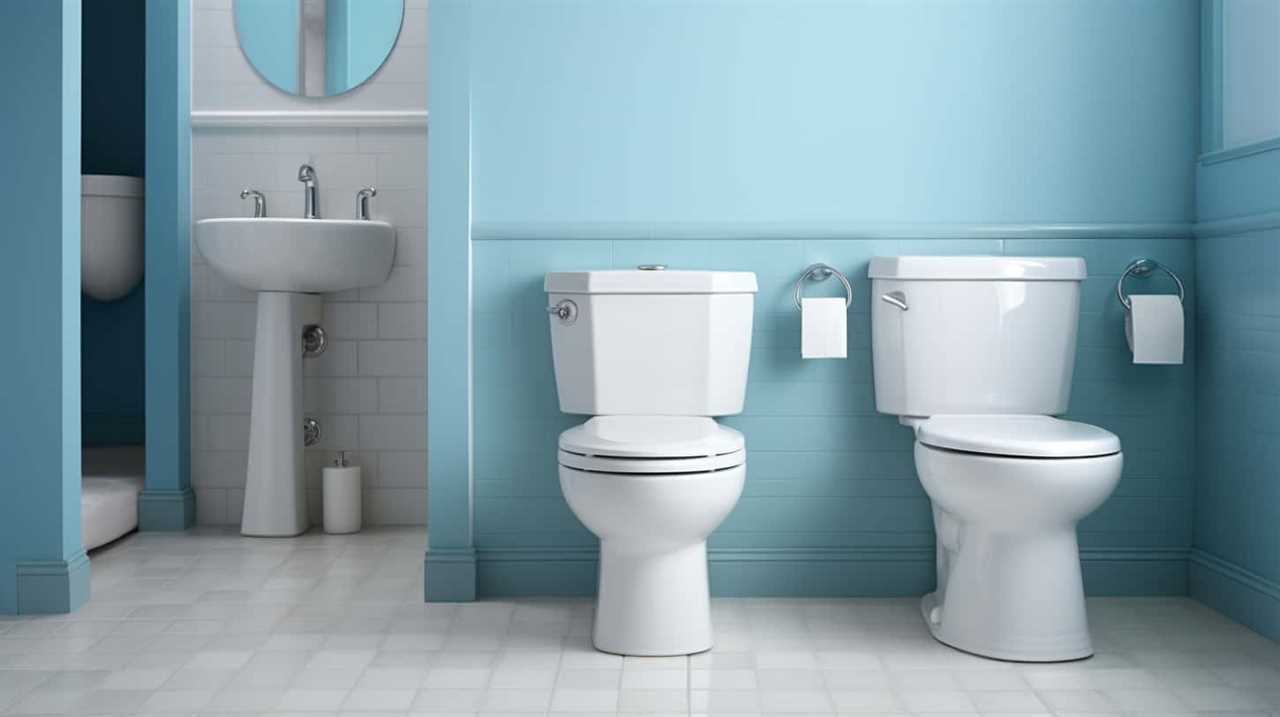
- The waste disposal process: Understanding how waste is transported through the pipes and eventually treated is crucial for maintaining a functional plumbing system.
- Sewage treatment methods: It is important to be aware of the different methods used to treat sewage, as this can affect the overall efficiency and effectiveness of the plumbing system.
- The importance of proper maintenance: By following proper maintenance practices, we can ensure the longevity and efficiency of our plumbing system, preventing potential issues and costly repairs in the future.
Waste Disposal Process
To understand the waste disposal process, let’s delve into the fascinating world of plumbing. Waste disposal methods and waste management techniques are crucial aspects of maintaining proper sanitation and hygiene.
When you flush the toilet, the waste travels through a series of pipes and ultimately ends up at a wastewater treatment plant. The plumbing system in your home or building plays a vital role in this process. It ensures that the waste is efficiently transported away from your living space and into the sewer system.
The pipes are designed to carry the waste without any leaks or blockages. The plumbing system is carefully engineered to ensure that the waste is disposed of properly and safely.
Sewage Treatment Methods
Once the waste from the toilet is flushed, it enters into and travels through a complex network of pipes that transport it to the wastewater treatment plant.

At the treatment plant, the sewage undergoes a series of processes to remove harmful contaminants and make it safe for disposal or reuse.
The first step in the treatment process is called primary treatment, where solid materials are removed through sedimentation and filtration.
Next, the water undergoes secondary treatment, which involves the use of biological processes to break down organic matter and remove dissolved contaminants.
After secondary treatment, the water goes through disinfection to kill any remaining bacteria and pathogens.
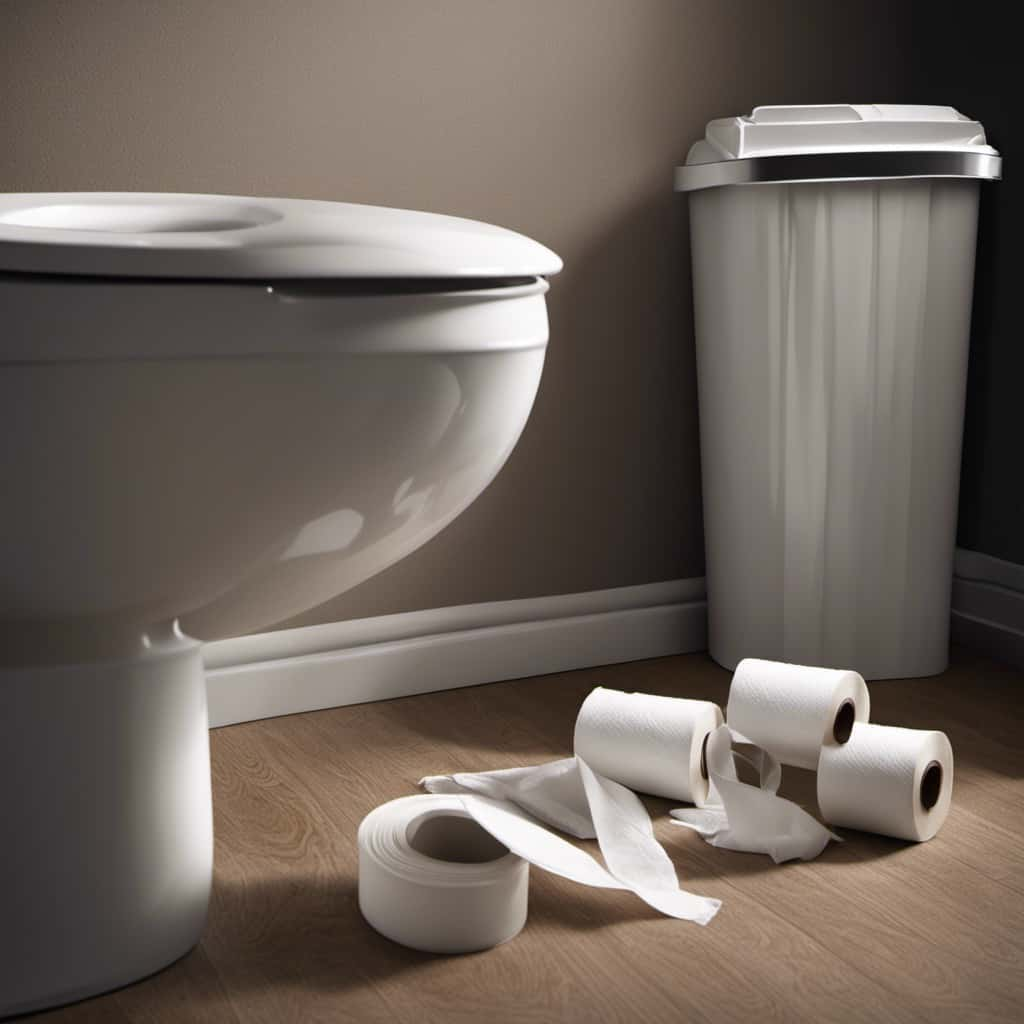
Finally, the treated water is discharged into nearby water bodies or used for various purposes such as irrigation or industrial processes.
This comprehensive sewage treatment process ensures that water is treated effectively and safely for disposal, protecting both human health and the environment.
Importance of Proper Maintenance
After the waste from the toilet is transported to the wastewater treatment plant, it’s important for proper maintenance of the plumbing system to be prioritized. Regular inspection of the plumbing system is crucial to ensure its optimal functionality and prevent any potential issues. Here are the benefits of professional maintenance:
- Early detection of problems: Professionals can identify and address any plumbing issues before they escalate into major problems. This helps to minimize the risk of costly repairs or replacements in the future.
- Increased lifespan of the plumbing system: Regular maintenance ensures that the pipes, fixtures, and other components of the plumbing system are well-maintained and functioning properly. This can extend the lifespan of the system, saving you money in the long run.
- Improved water efficiency: A well-maintained plumbing system is more efficient, reducing water wastage and lowering utility bills. Professionals can identify and fix any leaks or inefficiencies, ensuring that your plumbing system operates at its best.
Making Its Way to the Sewer System
Now that we understand how waste is transported through the plumbing system, let’s examine how it makes its way to the sewer system.
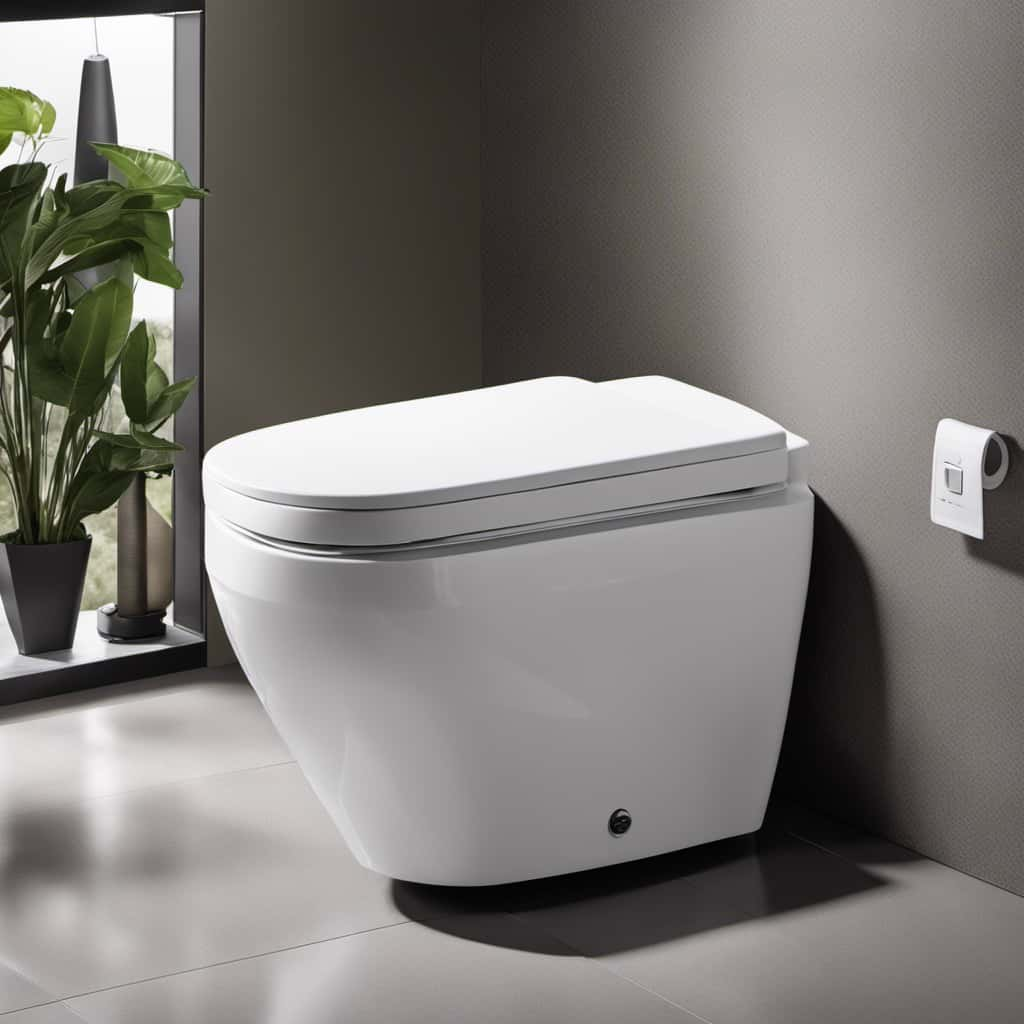
The waste disposal process involves the transfer of sewage from individual households and businesses to a centralized sewer system. Once in the sewer system, various sewage treatment methods are employed to remove contaminants and ensure the water is safe for disposal or reuse.
It’s important to consider the environmental impacts of sewage, as improper treatment and disposal can lead to pollution of water bodies and harm to ecosystems.
Waste Disposal Process
We flush the toilet, and our waste begins its journey through the waste disposal process, making its way to the sewer system. Here is a step-by-step explanation of how this process unfolds:
- Collection: After flushing, the waste travels through the plumbing system in our homes, joining a network of pipes that connect to the main sewer line.
- Transportation: The waste is then transported through the sewer system, using gravity or pumps, depending on the topography of the area. It moves through a network of pipes, gradually making its way to a wastewater treatment plant.
- Water Treatment: Once at the treatment plant, the waste undergoes a series of rigorous processes to remove contaminants and pollutants. These include physical, chemical, and biological treatments, such as screening, sedimentation, and disinfection. The treated water is then released back into the environment.
Understanding the waste disposal process is essential for maintaining proper sanitation and protecting our environment.

Sewage Treatment Methods
Our waste, along with the waste from other households, is collected and transported through a network of pipes to the sewer system. Once it reaches the sewer system, the sewage goes through a series of treatment methods to ensure proper water purification and sewage disposal.
The first step in the process is called primary treatment, where large objects and solids are removed from the sewage through screening and sedimentation.
Then, the sewage undergoes secondary treatment, which involves the use of bacteria to break down organic matter and remove any remaining solids.
Next, the treated water goes through a disinfection process to kill any harmful bacteria or viruses.

Finally, the water is discharged into a receiving body of water or it can be further treated for reuse.
This comprehensive sewage treatment process ensures that our waste is properly managed and that the water we use is purified before being returned to the environment.
Environmental Impacts of Sewage
As sewage makes its way to the sewer system, it can have significant environmental impacts. The improper disposal of sewage can lead to water pollution and ecosystem disruption. Here are three ways in which sewage can harm the environment:
- Contamination of water bodies: When sewage is discharged into rivers, lakes, or oceans without proper treatment, it introduces harmful bacteria, viruses, and chemicals into the water. This can lead to the spread of diseases and the death of aquatic organisms.
- Nutrient imbalance: Sewage contains high levels of nutrients such as nitrogen and phosphorus. When these nutrients enter water bodies, they can cause excessive growth of algae, leading to oxygen depletion and the death of fish and other aquatic life.
- Habitat destruction: Sewage discharges can alter the physical and chemical properties of the environment, destroying habitats for plants and animals. This disruption can have long-lasting effects on the delicate balance of ecosystems.
It is crucial to implement effective sewage treatment methods to minimize these environmental impacts and protect our natural resources.

Underground Pathways: Navigating the Sewer Lines
Navigating the sewer lines involves understanding the intricate pathways that wastewater takes underground. The underground infrastructure consists of a network of pipes and tunnels that transport sewage from homes and businesses to treatment plants. Maintaining this sewage network is crucial to ensure the proper functioning of the system. Regular maintenance includes inspecting and repairing any damaged pipes, clearing blockages, and ensuring the flow of wastewater is uninterrupted.
To navigate the sewer lines effectively, professionals use specialized equipment such as cameras and robotic devices to assess the condition of the pipes and identify any potential issues. This meticulous approach ensures that the wastewater can flow smoothly and reach its destination for treatment.
Now, let’s take a closer look at what happens when the wastewater arrives at the treatment plant.
Treatment Plant Arrival: A Glimpse Inside
As we arrive at the treatment plant, we witness the intricate process of waste purification. Our focus is on understanding the environmental impact considerations and the water recycling techniques employed here.

This glimpse inside the treatment plant gives us a deeper understanding of how our waste is transformed into a more sustainable and reusable resource.
Waste Purification Process
When we flush the toilet, the waste travels through the sewage pipes to the treatment plant. Once it arrives at the treatment plant, the waste undergoes a rigorous purification process to ensure safe disposal.
Here is a glimpse inside the waste purification process:
- Screening: The wastewater is first passed through screens to remove large debris such as sticks, plastic, and other solid objects.
- Sedimentation: The wastewater then enters large tanks where solid particles settle to the bottom, forming a layer of sludge.
- Biological Treatment: In this stage, microorganisms are introduced to break down organic matter in the wastewater. Oxygen is supplied to facilitate the growth of these microorganisms, which further purify the water.
Environmental Impact Considerations
Upon arrival at the treatment plant, we assess the environmental impact considerations of the waste purification process. It is crucial to understand the potential consequences of treating and disposing of wastewater to ensure the protection of our ecosystem health and prevent water pollution.

To illustrate the environmental impact considerations, we have provided a table below:
| Consideration | Description |
|---|---|
| Water Pollution | Evaluating the extent of pollutants present in the wastewater and their potential harm to aquatic life and water quality. |
| Ecosystem Health | Assessing the impact of treated effluent on the surrounding environment and the health of plants, animals, and microorganisms. |
Water Recycling Techniques
At the treatment plant, we employ various water recycling techniques to ensure the efficient and sustainable purification of wastewater. These techniques are crucial in addressing the pressing issues of water scarcity and promoting water conservation.
Here are three key techniques we use:
- Physical Treatment: The wastewater undergoes a series of physical processes, such as screening and sedimentation, to remove large debris and settle suspended solids.
- Biological Treatment: In this stage, microorganisms are introduced to break down organic matter present in the wastewater. This process, called activated sludge treatment, helps remove pollutants and nutrients.
- Chemical Treatment: To further purify the water, chemicals like chlorine or ozone are added to disinfect and eliminate any remaining bacteria and pathogens.
Primary Treatment: Removing Solid Waste
We remove solid waste during primary treatment by using a combination of physical and biological processes. The primary treatment phase is an essential part of the waste disposal process, as it focuses on removing large solid particles from the wastewater.

In this phase, the wastewater undergoes a series of steps to separate the solid waste from the liquid. The first step involves screening, where large objects like rags, plastics, and debris are removed using screens or grates.
After screening, the wastewater flows into settling tanks, allowing the heavier solid particles to settle at the bottom. These settled solids, known as sludge, are then scraped and removed for further treatment.
Once the solid waste is removed, the treated wastewater moves on to the next phase, which is the secondary treatment, where the focus is on breaking down organic matter.
Secondary Treatment: Breaking Down Organic Matter
When it comes to breaking down organic matter in the secondary treatment process, there are several key points to consider.
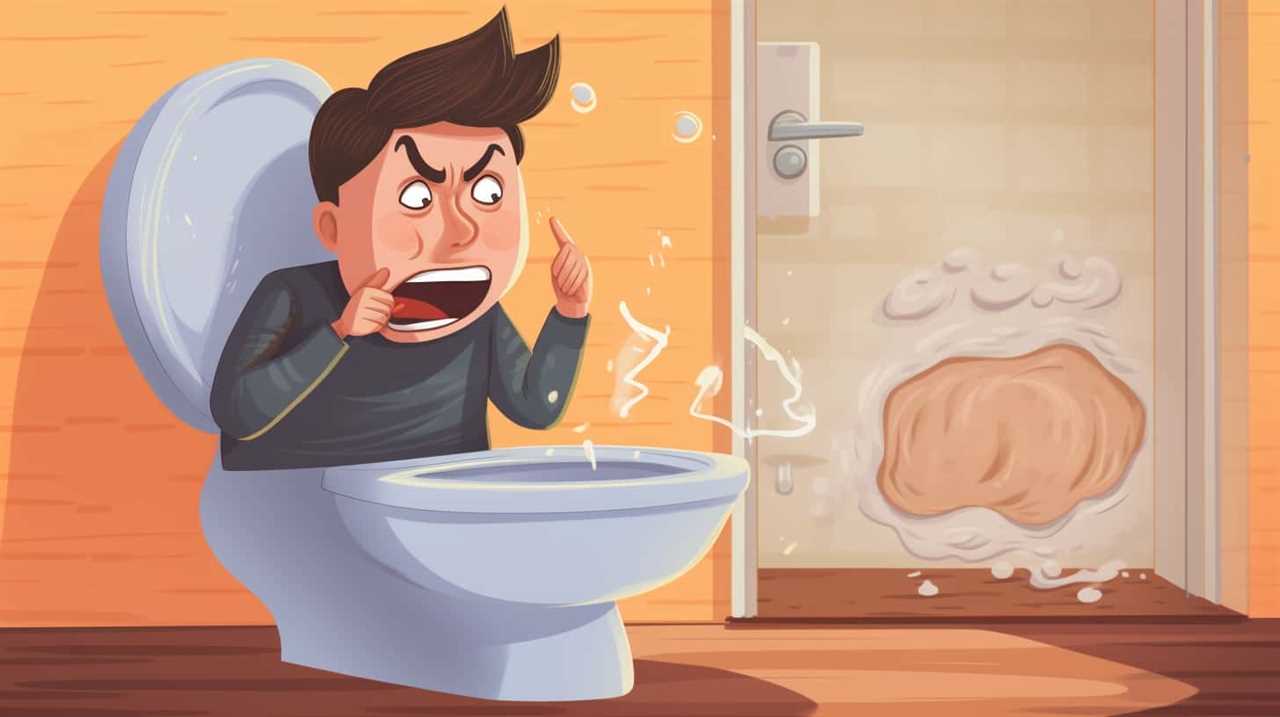
Firstly, this process involves the decomposition of organic materials through the use of microorganisms. These microorganisms play a crucial role in breaking down the organic matter into simpler compounds.
This process not only helps to remove harmful pollutants, but it also has positive environmental impacts, such as reducing the release of greenhouse gases and creating nutrient-rich byproducts that can be used as fertilizers.
Organic Matter Decomposition Process
During the organic matter decomposition process, bacteria and other microorganisms actively break down the waste flushed down the toilet. This waste decomposition process involves several steps that efficiently break down organic matter. Here is a list of the stages involved:
- Hydrolysis: Enzymes secreted by bacteria break down complex organic molecules into smaller components, such as proteins, carbohydrates, and fats.
- Acidogenesis: Acid-producing bacteria further break down these smaller components into simpler compounds like fatty acids, alcohols, and organic acids.
- Methanogenesis: Methanogenic bacteria convert these simpler compounds into methane gas and carbon dioxide through a process called methanogenesis.
These stages work synergistically to decompose the organic matter in the waste, transforming it into environmentally safe byproducts.

This efficient process is essential for maintaining proper sanitation and preventing the accumulation of harmful substances in our wastewater systems.
Role of Microorganisms
One important aspect of the wastewater treatment process involves the use of microorganisms to break down organic matter. Microbial digestion plays a crucial role in the secondary treatment phase, where the focus is on removing dissolved and suspended organic materials. This process helps to further break down the waste and convert it into simpler compounds that can be easily removed from the water.
To better understand the role of microorganisms in waste decomposition, let’s take a look at the following table:
| Microorganisms | Function | Examples |
|---|---|---|
| Bacteria | Breaking down complex organic compounds | Escherichia coli, Bacillus subtilis |
| Fungi | Decomposing cellulose and lignin | Aspergillus niger, Trichoderma reesei |
| Protozoa | Feeding on bacteria and other organic particles | Amoeba proteus, Paramecium caudatum |
These microorganisms work together to efficiently break down the organic matter present in wastewater, aiding in its treatment and ensuring cleaner water is returned to the environment. Their ability to digest and decompose waste is a vital part of the wastewater treatment process.

Environmental Impact and Benefits
The breaking down of organic matter through microbial digestion in the secondary treatment phase of wastewater plays a crucial role in minimizing the environmental impact and providing numerous benefits. This process not only helps in water conservation by reducing the amount of water needed for irrigation, but also prevents pollution by removing harmful pollutants from the wastewater.
Here are three key benefits of secondary treatment:
- Reduced Environmental Impact: Through the breakdown of organic matter, secondary treatment significantly reduces the amount of nutrients and contaminants that would otherwise be released into the environment, protecting water bodies and ecosystems.
- Improved Water Quality: By removing organic matter and contaminants, secondary treatment improves the quality of the treated water, making it safer for reuse or discharge into water bodies.
- Health Protection: Secondary treatment reduces the risk of waterborne diseases by eliminating pathogens and harmful bacteria from the wastewater.
As we move on to the subsequent section about tertiary treatment, we’ll explore how this final stage further polishes the effluent to meet even higher water quality standards.
Tertiary Treatment: Polishing the Effluent
After the wastewater goes through the secondary treatment process, it moves on to the next stage known as tertiary treatment, where the effluent is further polished. Tertiary treatment is a crucial step in water purification, ensuring that the effluent quality meets the highest standards before it’s released back into the environment.

During this stage, advanced treatment methods are employed to remove any remaining impurities, such as fine particles, dissolved organic matter, and nutrients. This is done through processes like filtration, disinfection, and advanced oxidation. These techniques play a vital role in improving the overall quality of the effluent and reducing the potential environmental impact.
As the effluent undergoes tertiary treatment, it becomes increasingly purified, preparing it for the final step in the treatment process: disinfection. This transition from tertiary treatment to disinfection is facilitated by the presence of bacteria, which play a crucial role in breaking down organic matter and aiding in the removal of pathogens.
The Role of Bacteria in the Treatment Process
During tertiary treatment, bacteria play a vital role in breaking down organic matter and aiding in the removal of pathogens. The effectiveness of microbial treatment is dependent on the presence of specific bacteria that possess the ability to degrade complex organic compounds. Here are three key ways in which bacteria contribute to the treatment process:
- Biodegradation: Bacteria utilize organic matter as a food source and break it down into simpler compounds through enzymatic reactions. This process reduces the concentration of pollutants and eliminates harmful substances.
- Nutrient Cycling: Bacteria play a crucial role in recycling essential nutrients, such as nitrogen and phosphorus. They convert these compounds into forms that can be taken up by plants, promoting the growth of aquatic vegetation and maintaining ecological balance.
- Pathogen Removal: Certain bacteria have the capacity to consume and neutralize pathogens present in wastewater. Through predation and competition for resources, these bacteria help eliminate disease-causing organisms, making the water safer for reuse or discharge.
Understanding the bacteria’s role in the treatment process is fundamental for optimizing wastewater treatment systems and ensuring the production of clean, safe water.
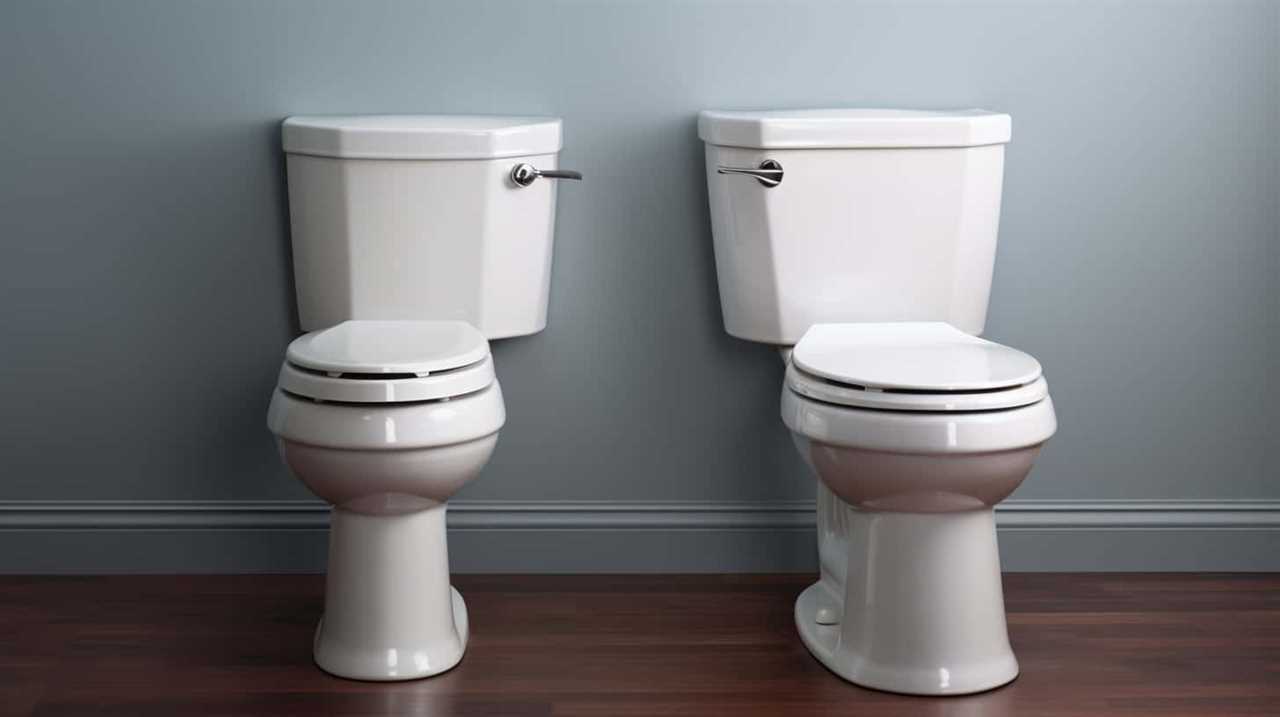
Disinfection: Eliminating Harmful Pathogens
Continuing from our previous discussion on the role of bacteria in the treatment process, let’s now delve into the important task of disinfection: eliminating harmful pathogens.
Disinfection methods play a crucial role in ensuring that treated wastewater meets the necessary water quality standards. These methods involve the use of various chemical, physical, and biological processes to target and destroy harmful microorganisms present in the wastewater.
Common disinfection methods include chlorination, ultraviolet (UV) radiation, and ozonation. Chlorination, the most widely used method, involves the addition of chlorine to the wastewater to kill bacteria, viruses, and other pathogens.
UV radiation utilizes ultraviolet light to disrupt the DNA of microorganisms, rendering them unable to reproduce.

Ozonation, on the other hand, employs ozone gas to oxidize and destroy harmful organisms.
These disinfection methods are carefully regulated to ensure that the water quality standards are met and that the treated water is safe for reuse or discharge into the environment.
The Final Destination: Where Does the Treated Water Go
Once the harmful pathogens have been eliminated through disinfection methods, we can now explore the final destination of the treated water. The goal of water reclamation is to take this once contaminated water and transform it into a resource that can be reused in a sustainable manner. Here is a glimpse into where the treated water goes:
- Irrigation: One common use for reclaimed water is irrigation. It can be used to water crops, parks, and golf courses, reducing the need for freshwater sources.
- Industrial Processes: Reclaimed water can also be used in various industrial processes, such as cooling systems or manufacturing. This reduces the demand for freshwater in these industries.
- Groundwater Recharge: In some cases, treated water is injected into the ground to replenish groundwater supplies. This helps maintain the balance of aquifers and supports overall water sustainability.
Reclaimed Water: Potential Uses and Benefits
After exploring the final destination of treated water, let’s now delve into the potential uses and benefits of reclaimed water.

Reclaimed water, also known as recycled water or wastewater, is treated sewage water that has undergone a rigorous purification process to remove impurities and contaminants. This process allows reclaimed water to be reused for various purposes, contributing to water conservation efforts.
One of the main benefits of water reuse is its potential for irrigation. Reclaimed water can be used for watering crops, parks, and golf courses, reducing the demand for freshwater resources.
Additionally, reclaimed water can be utilized in industrial processes, such as cooling systems and manufacturing processes. This helps conserve freshwater resources and reduces the strain on the environment.
Biosolids: What Happens to the Solid Waste
When we flush the toilet, the solid waste goes through a process called biosolids management to determine its final destination. Biosolids management involves several steps to ensure proper handling and treatment of solid waste. Here is a breakdown of what happens to the solid waste during this process:

- Thickening: The first step is to remove excess water from the waste, which is done through thickening. This reduces the volume and makes it easier to handle.
- Stabilization: The thickened waste is then treated to stabilize it, ensuring that any harmful pathogens are destroyed. This is typically done through processes such as anaerobic digestion or composting.
- Nutrient recovery: After stabilization, the waste is further processed to recover valuable nutrients such as nitrogen and phosphorus. These nutrients can then be used as fertilizers in agriculture or other applications.
By properly managing biosolids, we can minimize environmental impact and maximize the potential benefits of solid waste.
Now, let’s explore the importance of proper waste management and its impact on the environment.
Environmental Impact: The Importance of Proper Waste Management
To understand the environmental impact of proper waste management, let’s explore how our actions can minimize harm and maximize benefits.
Water pollution is a significant concern when it comes to waste management. Improper disposal and treatment of waste can lead to the contamination of water sources, causing harm to aquatic ecosystems and posing risks to human health. Sustainable practices are crucial in mitigating these risks and ensuring the long-term health and well-being of our environment.

By implementing effective waste management strategies, such as proper sewage treatment and recycling systems, we can reduce the amount of waste that ends up in our waterways. This not only protects the quality of our water resources but also promotes the conservation of natural resources and the preservation of biodiversity.
It’s our responsibility to adopt sustainable waste management practices to minimize water pollution and safeguard our planet for future generations.
Conclusion
In conclusion, understanding the journey of where our flushed waste goes is crucial for proper waste management.
Did you know that each flush can use up to 3.5 gallons of water? That’s equivalent to 26 water bottles!

By learning about the intricate process from the toilet bowl to the treatment plant, we can appreciate the importance of conserving water and ensuring that our waste is properly treated and managed.
Let’s all do our part in preserving our environment for future generations.










